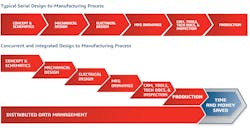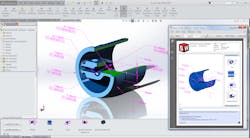Smart Manufacturing: Connecting the Dots from Design to Manufacture
Today’s manufacturers must compete in an increasingly global market. Design cycles are shrinking, global competition makes it harder than ever to stand out, customers are becoming increasingly selective, and today’s ever-changing political climate has led to tariffs that have made the playing field in many industries uneven (at best).
To survive, businesses must strive to keep existing customers happy, expand into new markets, and gain new customers. That’s a tall order, considering the endless amount of choices today’s customers are offered and the shortened design cycles they must work within. Innovation is often the secret to success for manufacturers—not just in design but in how they produce and bring their products to market. Even the most innovative products will fail, however, if they don’t make it to market in a timely manner.
The one certainty about engineering is that it’s always changing. Advancements in technology and intense competition, both at home and abroad, will always push organizations to innovate new processes for product development. By taking an integrated approach to get products from design to manufacturing, organizations can easily accelerate their development process.
Let’s take a look at how advancements in the design-to-manufacturing process can help companies overcome these challenges and bring innovative products to market faster.
Bridging the Gap Between Design and Manufacturing
Historically, design has been treated as a separate process from manufacturing, with each group using their own set of specific tools that don’t easily share information between them. Siloed organizational structures and adherence to outdated processes have only added to the challenges.
This divide inevitably leads to costly mistakes that wreak havoc on timetables, budgets, and talent. Loss of critical information; fragmentation and alteration of design concepts; loss of product and process knowledge; stagnation in original, innovative ideas—all are compounded results of this disjointed process.
Engineering and manufacturing must be able to share and exchange design information and, because they use different tools, the data that is being shared often needs to be imported and repaired. Not only is this tedious and time-consuming, but the translation process can introduce errors.
Any design problems found during production can cause further delays. Perhaps there isn’t enough clearance to drill a hole or maybe tolerance stack up has caused a misalignment with the mounting holes. Whatever the problem, it takes time to come up with a solution. This puts schedules at risk and can delay time-to-market. On top of that, bad parts need to be scrapped or reworked, adding even more cost.
To create an alternative to this divide, a bridge between product design and manufacturing requires not just new tools, but a new, integrated approach to how parts and products are made. Only by rethinking the entire development workflow can faster, stronger, and more collaborative methods be realized. When the tools are well integrated, products can move from concept to manufacturing quickly because design teams can work concurrently without the error-prone process of porting data from one system to another.
Finding a Smarter Way
By integrating and connecting design, different manufacturing processes can occur when it is required rather than having to occur in a sequential order, which can hinder efficiency.
Smart manufacturing is a term used to describe a connected and seamless flow of intellectual property (IP) to all teams involved, from design to manufacturing. The creation of IP involves knowledge-capture early in the design process with intelligence from varied skill sets, such as design, costing, quality, manufacturing, marketing, and supply chain. In smart manufacturing, information is available when it’s needed, where it’s needed, and in the form in which it is most useful. Manufacturing intelligence is built up front to actively integrate the three major components in the development process: design, manufacturing, and innovation.
To make a connection between IPs to work, an integrated set of tools are needed to enable design and manufacturing teams to work together, without having to export and import data from one system to another. With everyone on the team speaking the same language—or in this case, using the same tools—there are no miscommunications or data loss as a result of translation errors when design data is passed between design and manufacturing.
The key to making smart manufacturing work is keeping design IP at the center of all efforts—both early in concept development and detailed design—all the way through to final manufacturing, inspection, and assembly. In this way, the entire process works to serve the design that best serves the needs of the customer. It also helps companies make better decisions, which leads to better products, shorter time to market, and the agility to respond more quickly to customer demands.
With IP embedded in the 3D design model, and at the center of the model-based definition (MBD) process, changes from design or manufacturing automatically flow to all related CAD models, CAM programs, drawings, and documentation. Thus, changes become faster and easier to handle.
Optimization of design for function and manufacturability becomes natural to the teams. Additionally, all the information for manufacturing, inspection, and simulation and verification is directly linked to the design, so it always reflects the current design iteration.
MBD: A New Game-changer
Model based designs offer a better connection platform for designers and manufacturers.
Most manufacturers are aware of model-based definition (MBD). For many years, however, only the larger companies forced to comply with various industry regulations quickly adopted it, mostly out of necessity. But today, MBD has become a game-changer for many companies, and those who have adopted it are very happy they did. In a Tech-Clarity eBook, “How-to Guide to Implementing MBD,” nearly 90% of those who have adopted MBD were either “satisfied or extremely satisfied.”
Engineers spend approximately 33% of their design time on drawings, much of this time spent documenting what is already in the 3D model. This is where MBD comes in. MBD is when product and manufacturing information (PMI) is embedded into the CAD model to support all the necessary downstream processes, such as manufacturing, analysis, and inspection. This information can include GD&T, 3D annotations, surface finish, and material specifications.
By reducing all that time spent creating 2D drawings, engineers can focus more effort on value-added tasks that will improve the design and result in products that are more competitive. The most common benefit of implementing MBD is better communication with manufacturing and suppliers. An added benefit is that your engineers will be happier when they can spend their time innovating and designing, and not on tedious tasks.
Manufacturing that Follows the Rules
In today’s global manufacturing ecosystem, the market is changing significantly and re-defining contract manufacturing. To help designers and engineers respond to these changes, some integrated design-through-manufacturing tools enable knowledge capture for great automation of manufacturing and enables them to more carefully consider manufacturing methods during the design phase.
Rules-based machining with knowledge capture allows for the automation of manufacturing programming, and lets engineers and designers execute CAM programming and tasks. By doing so, they gain a greater understanding of how their designs are made, leading to the creation of less-expensive and easier-to-produce products. The method also allows design teams to create prototype parts faster than outsourcing, and can bring critical manufacturing in-house to control quality, cost, and delivery.
This option to “build to order” enables a company to customize and personalize their products online using automated design and manufacturing functions. Designers and engineers can now create CAD prototypes without having to deal with production runs or use outside vendors. Having a connected design system compresses the timeframe for manufacturing, allowing turnaround in as little as 24 hours and facilitating in-house production.
By eliminating redundancies and automating parts of the design-to-manufacturing process, engineering talent is freed from repetitive tasks, so they can focus on creating tomorrow’s great new products. The focus is no longer on the process of moving information, but on maximizing ideas and design.
Craig Therrien is a SOLIDWORKS Senior Product Portfolio Manager for Dassault Systèmes.



